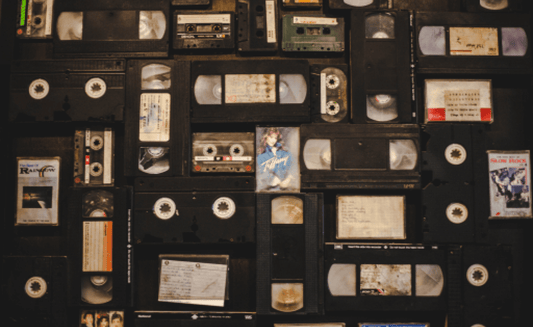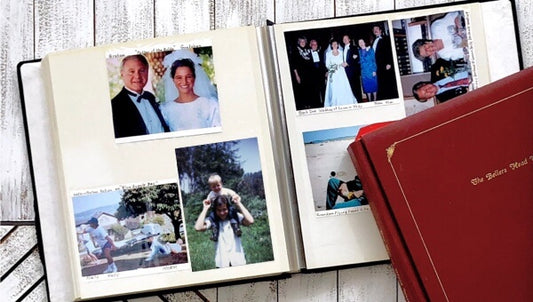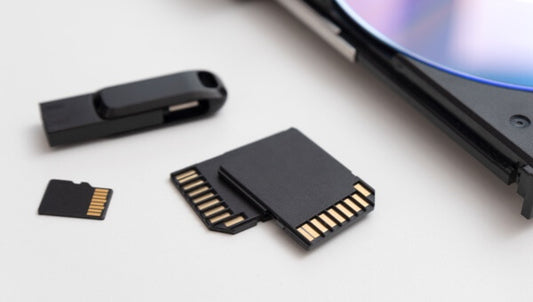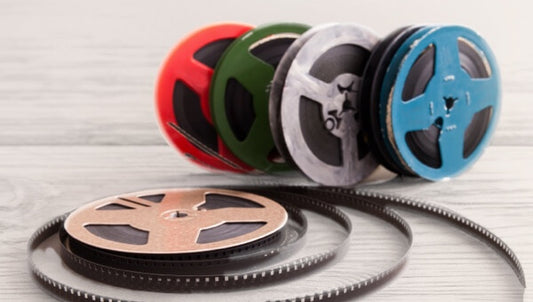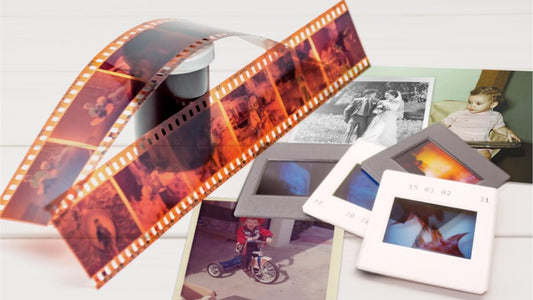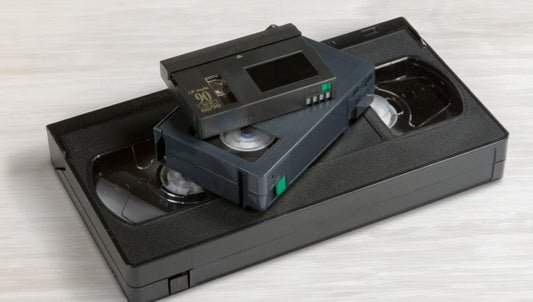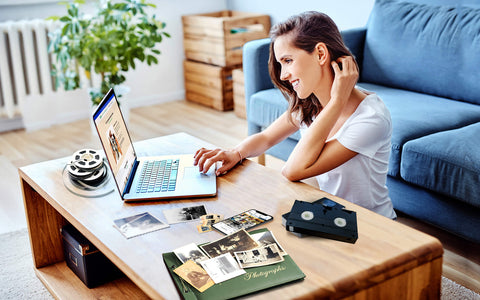Home movies capture our most important memories like holidays, family gatherings, graduations, weddings, and celebrations. Whether you grew up in the late 1960s on Super 8 film or in the 80s or 90s with VHS and other videotapes, these formats helped shape and capture your memories.
At Capture, we transfer nearly every home movie format, including 8mm film reels, 16mm film, Super 8 film, and popular videotapes like VHS and Betamax. To help you revisit those special times, we’ve created this guide to the evolution of home movie formats.
Here, you’ll learn about the original home movie film formats, the game-changing arrival of Super 8, the rise of magnetic videotapes, and the beginnings of the digital video age - all milestones that kept family memories alive.
Jump To:
- A Journey Through Time Old Home Movie Formats
- Super 8 Film A Revolution in Home Movies
- The Era of Magnetic Tape VHS and Betamax
- The Digital Age Streaming and Easy Storage
- Preserving and Converting Old Home Movie Formats
- Old Home Movie Formats and the Future of Your Memories
A Journey Through Time: Old Home Movie Formats
When the first video was recorded in the 1800s, home movies weren’t a thing, but within about 50 years, 16mm film would be introduced to the amateur filmmaking market. Brought to the public by Eastman Kodak in 1923 alongside the first successful consumer movie camera, the Cine-Kodak, it marked the beginning of personal filmmaking.

Many families still treasure old home movie formats because they hold priceless memories that deserve to be preserved and shared.
While 16mm was groundbreaking, it wasn’t exceptionally convenient and was marketed more toward serious hobbyists than everyday families. The technology quickly evolved, with a major milestone in 1935: the introduction of Kodachrome, Kodak’s signature color reversal film, which added vibrant, long-lasting color and optical soundtracks. Kodachrome could be used for both motion pictures and still photography, but it wasn’t until the arrival of 8mm film that home movies truly became accessible.
Invented at Kodak headquarters in Rochester, New York in 1932, 8mm film was smaller, more affordable, and far easier to handle than 16mm reels. Its unique design allowed users to flip the film and record on both sides, effectively doubling recording time. This innovation revolutionized the home movie industry. Families everywhere began experimenting with motion photography, and 8mm film cameras quickly became household staples.
Despite its popularity, 8mm had limitations. Sound recording wasn’t supported until the 1960s, and even then, it was rarely used in standard 8mm films. The desire for accessible sound, however, paved the way for the next major advancement: the arrival of Super 8 film, which would dominate the home movie market in the decades to come.
Super 8 Film: A Revolution in Home Movies
When it comes to 8mm vs Super 8, the differences were significant. Released in 1965, the Super 8 film quickly became the standard for home moviemaking, adopted by amateur filmmakers and millions of families worldwide. Compared to regular 8mm, the new format had smaller sprocket perforations, allowing more of the film strip to capture images for higher picture quality. The biggest change, however, was the potential for synchronized sound, something standard 8mm never offered.
Super 8 cameras could not originally capture sound, but the film format has a rust-colored magnetic strip that could accommodate sound after film processing. Pretty soon, film projectors started to add audio capability including the ability to both record and play sound. This transformed the home movie experience and made recording memories far more personal.
This addition also changed how projectors work. Instead of being simple visual machines, projectors evolved into multimedia devices capable of playing synchronized soundtracks. By the early 1970s, many included built-in speakers and microphones, making home movies more dynamic and interactive.
By 1973, Super 8mm cameras could record sound directly, leading to a major increase in home movie enthusiasts. As one of the most iconic old home movie formats, Super 8 remains remembered for bringing color, clarity, and sound into everyday family films.

Early Super 8 cameras were silent, but the film’s rust-colored magnetic strip allowed sound after processing.
Key advantages of Super 8 included:
- Higher picture quality
- Sound-ready film stock
- Easier-to-load cartridges
- Affordable and widely available equipment
Still, its popularity was short-lived. Videotape formats like Sony’s U-Matic, introduced in 1971, offered longer recording times, instant playback, and easier editing - quickly overshadowing film-based home movies.
The Era of Magnetic Tape: VHS and Betamax
The rise of magnetic tape changed everything about home movies. Videotape used a magnetic strip to store video and sound, creating the foundation for a new era. This sparked the battle of VHS vs Betamax, one of the most important format wars in media history.
VHS & Betamax
Sony introduced Betamax in 1975, first in Japan and then in the United States. Two years later, JVC released the VHS format in 1977. Betamax offered sharper images, better sound, and smaller cassette cases. JVC, however, shared its VHS technology with brands like RCA and Panasonic, making it cheaper and widely available. That decision shaped what was popular in the 80s, from family recordings to favorite films.
The lower cost and longer recording times made VHS the winner. Soon, every rental shop carried VHS tapes. Families could bring home comedies, action flicks, and even horror movies from the 80s. Betamax faded from the mainstream within a decade.
VHS C
Other tape versions also appeared. VHS-C was a compact format designed for portability. It fit perfectly into an old video camera or camcorder, giving families a simpler way to record life. With smaller cassettes and adapters for standard players, VHS-C became another step toward video accessibility.
8mm tape formats
Meanwhile, 8mm tape formats advanced the technology. Devices like Hi8 tape players and Video8 cameras offered better image quality and longer recording times. Hi8 was still analog but could support digital audio tracks. Later, Digital8 tapes pushed the trend closer to modern recording and bridged analog with digital systems.
Then, in 1995 the DV video cassette format was released with options like the MiniDV, but it wouldn’t last due to the ease of use of fully digital options that didn’t require a physical copy.

After the first digital camera, video cameras soon followed, letting families record in better quality and transfer footage to computers.
The Digital Age, Streaming, and Easy Storage
After the invention of the first digital camera, digital video cameras quickly followed. Families could now record events more easily, with higher quality and the ability to transfer videos straight to computers. This shift also meant home movies could be stored, backed up, and shared online instead of relying on fragile tapes.
As the 2000s arrived, DVDs and Blu-Rays replaced videotapes, offering clearer images and longer storage life. Soon after, SD cards and USB drives became common, providing compact and reliable ways to save home movies. These storage options helped protect family memories in ways older physical media never could.
It wasn’t long before platforms like Netflix also popped up (though it started as a mail-in DVD rental company), which allows us to access entire libraries of movies from almost any device. This same concept can be applied to cloud storage options like Google Photos or Dropbox.
We can now use digital video cameras to record home movies, transfer digital files to other devices, share over social media and email, edit with video editing software, and much more.
Preserving and Converting Old Home Movie Formats
Whether you have VHS tapes, camcorder cassettes, or classic film reels, preserving them properly is the first step toward protecting your memories. Many old home movie formats are fragile and prone to water damage, fading, or data loss if not stored correctly.

Professionals use advanced equipment and techniques to preserve every frame, ensuring your memories remain in the best quality.
Best Practices for Storing Home Movie Formats
To make sure your tapes and reels last as long as possible:
- Keep them in a cool, dry, and dark place to prevent fading and mold
- Avoid extreme temperatures and humidity that can warp film and tape
- Protect from dust and debris by storing in cases or containers
- Keep VCR systems and projectors stored under the same conditions
- Organize them carefully so you don’t need to handle or move them often
Why Digitizing Old Home Movie Formats Matters
Even with careful storage, film reels and videotapes degrade over time. Transferring your home movie formats to digital ensures they last for generations. A digital copy can be saved on hard drives, cloud storage, DVDs, smartphones, or even shared directly on social media.
You can:
- DIY digitize using camcorder-to-digital converters, VCR transfer machines, or film scanners
- Use a professional service to digitize 8 film, 16mm, and older videotape systems to guarantee the best results
Old Home Movie Formats and the Future of Your Memories
There are many different old home movie formats from silent home movies to early video cameras all the way to the digital era. Preserving old home movies can help those old analog formats last forever while still retaining the nostalgia and memories we connect with the formats we grew up with.
If you need help digitizing home movies Capture can help! With professional transfer services we help families safeguard their most meaningful moments.





